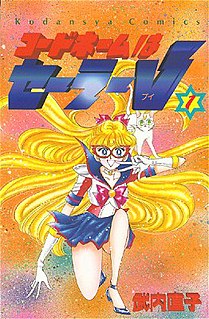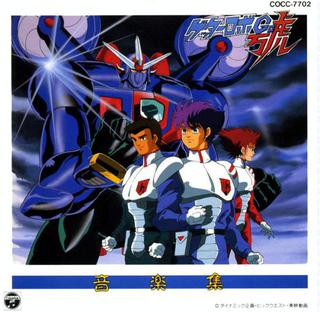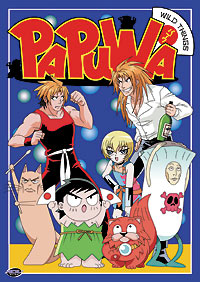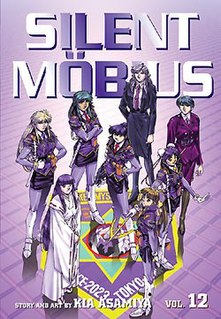 W
W801 T.T.S. Airbats, known in Japan as Aozora Shōjotai , is a manga by Shimizu Toshimitsu which was later adapted into a seven episode anime series, produced by Studio Fantasia and Victor Entertainment. The series was released in Japan on LaserDisc as a series of OVA episodes between 1994 and 1996, and was licensed for English language distribution by ADV Films. The title has been out of print since 2005. The series had aired on TVB in Hong Kong on April 9, 1996.
 W
WAa Harimanada (ああ播磨灘) is a Japanese media franchise that began with a 1991 manga by Kei Sadayasu published in Kodansha's Weekly Morning. An anime television series was broadcast in 1992. The series was later adapted to a video game developed and published by Sega for the Sega Game Gear and Sega Mega Drive. A port was also released on the Game Boy, released by ASK.
 W
WAkagi: Yami ni Oritatta Tensai is a Japanese manga written and illustrated by Nobuyuki Fukumoto. First published in 1991 in Takeshobo's weekly magazine Kindai Mahjong, it is a spin-off prequel of the author's previous work, Ten. It revolves around Shigeru Akagi, a boy who defeats yakuza members well versed in mahjong at 13. He returns to the game six years later, carrying a mythical status and still impresses his opponents.
 W
WAkazukin Chacha is a Japanese shōjo manga series by Min Ayahana. It was serialized by Shueisha in the manga magazine Ribon from 1991 to 2000 and collected in 13 bound volumes. The series is loosely based on the fairy tale Little Red Riding Hood and follows the adventures of a fumbling student magician named Chacha, who habitually wears a red hooded cloak, as she seeks the truth about her family and defend the kingdom against its enemies.
 W
WAo no Fūin is a shōjo manga series by Chie Shinohara which was serialized in the manga magazine Shōjo Comic from issue 22 in 1991 until 1994. The story is about a beautiful high school girl, Sōko Kiryū, who finds out she is the latest reincarnation of Sōryū, the demon queen who once ruled the earth with her demon armies. Unfortunately, she has fallen in love with a boy named Akira who is the reincarnation of Byakko, the legendary white tiger who is destined to kill her.
 W
WBaby & Me is a shōjo manga by Marimo Ragawa. It was originally published in Japan by Hakusensha, and was published in English by Viz Media, serialized in the magazine Shojo Beat. It received the 40th Shogakukan Manga Award for shōjo in 1995. The series was adapted as an anime television series in 1996.
 W
WGrappler Baki , known as Baki the Grappler in North America, is a manga series written and illustrated by Keisuke Itagaki. It was originally serialized in Weekly Shōnen Champion from 1991 to 1999 and collected into 42 tankōbon volumes by Akita Shoten. The story follows teenager Baki Hanma as he trains and tests his fighting skills against a variety of different opponents in deadly, no rules hand-to-hand combat.
 W
WBenkei in New York is a one-volume manga written by Jinpachi Mori and illustrated by Jiro Taniguchi. It is a collection of short stories revolving around a Japanese artist who moves to New York, but secretly works as a hitman in his spare time. It was originally serialized in the Japanese manga magazine Big Comic Original by Shogakukan between 1991 and 1996. The manga was serialized in North America by Viz Media in its Pulp magazine in 2000 and later collected in graphic novel format. Critics have praised the series for its uniqueness compared to North American crime fiction as well as its execution of horror.
 W
WBlue Hole is a science fiction manga series by Yukinobu Hoshino about the discovery of a gateway in time and space deep underwater which allows for travel between the present day and the age of the dinosaurs. Its title in France is Le Trou Bleu. It was serialized in Mister Magazine from 1991 to 1992 with two tankōbon published.
 W
WBoys Be... is a manga series written by Masahiro Itabashi and illustrated by Hiroyuki Tamakoshi. It was later adapted into a 13 episode anime television series by Hal Film Maker in 2000.
 W
WCodename: Sailor V is a manga created by Naoko Takeuchi. The series revolves around the character Minako Aino, a cheerful schoolgirl who finds out that she has magical powers that she must use to protect the people of the Earth. Codename: Sailor V is the basis for its sequel, Pretty Soldier Sailor Moon.
 W
WDetonator Orgun is a 1991 Japanese original video animation series by AIC and Artmic, directed by Masami Ōbari with character designs by Kia Asamiya. Planning for the series started in 1989, but the animation process did not start until 1991. The series was released on DVD in 2001 by Central Park Media in the United States, in 2002 by Happinet Pictures in Japan, and in 1997 by Manga Entertainment in the United Kingdom. Orgun later appeared in the Super Robot Wars W video game.
 W
WDuklyon: Clamp School Defenders is a manga created by Clamp, a Japanese artistic group of four women. It ran from 1991 to 1993 in Newtype Comic Genki.
 W
WEarl Cain , also known as Count Cain, is a gothic shōjo manga series written and illustrated by Kaori Yuki. Earl Cain consists of five parts or "Series": Forgotten Juliet , The Sound of a Boy Hatching , Kafka , The Seal of the Red Ram , and the sequel series Godchild .
 W
WFuriten-kun (フリテンくん) is a yonkoma manga series by Masashi Ueda which has been serialized in several magazine. In the early 1980s, the manga was published simultaneously in Takeshobo's Kindai Mahjong, Kindai Mahjong Original, and Gamble Punch. It was then published in Manga Life magazine from November 1984 to 1994. The series was started again in January 2001 and is currently running in Manga Life. The title of the series was changed to Shin Furiten-kun (新フリテンくん) in March 2002. The manga was adapted into a theatrical film and an OVA in the early 1980s.
 W
WGetter Robo Go or Getter Robot Go, also known as Venger Robo or Venger Robot Go outside Japan, is a Japanese mecha anime and manga series created by Go Nagai and Ken Ishikawa.
 W
WGhost in the Shell is a seinen manga series written and illustrated by Masamune Shirow, which spawned the media franchise of the same name. The manga, first serialized in 1989 under the subtitle of The Ghost in the Shell, was later published in one tankōbon volume by Kodansha. Set in the mid-21st-century, it tells the story of the fictional counter-cyberterrorist organization Public Security Section 9, led by protagonist Major Motoko Kusanagi. Ghost in the Shell 2: Man-Machine Interface was the sequel work which follows the story of Motoko after merging with the Puppeteer. The last volume, Ghost in the Shell 1.5: Human-Error Processor, contains four separate cases.
 W
WGhost Sweeper Mikami: The Great Paradise Battle!! is a Japanese manga series written and illustrated by Takashi Shiina. It was published in Shogakukan's Weekly Shōnen Sunday from 1991 to 1999. In 1993, it won the Shogakukan Manga Award for best shōnen manga. The series explores some folk religion themes such as possession, exorcism, shamanism, Yurei, and Yōkai.
 W
WGo!! Southern Ice Hockey Club is a Japanese shōnen manga series written and illustrated by Kōji Kumeta. It was serialized in Shogakukan's Weekly Shōnen Sunday from April 1991 to August 1996, and compiled into twenty-three tankōbon volumes.
 W
WGon is a Japanese manga series created by Masashi Tanaka. The Gon series features the completely wordless adventures of the irascible, tiny dinosaur and the title character, as he interacts with the natural world, depicted by Tanaka in lush, realistic detail. Gon somehow survived the extinction of his fellow dinosaurs and interacts with paleolithic animals.
 W
WGunsmith Cats is a Japanese seinen manga series written and illustrated by Kenichi Sonoda. It was published in Kodansha's Afternoon from 1991 to 1997 and was followed between 2004 and 2008 by a sequel series Gunsmith Cats Burst which included the same characters and situations.
 W
WThe Heroic Legend of Arslan is a Japanese fantasy novel series written by Yoshiki Tanaka. It was first published in 1986 and ended in 2017 with sixteen novels and one side-story in the official guidebook Arslan Senki Dokuhon. Set in ancient Persia, it is loosely based on the Persian epic of Amir Arsalan.
 W
WItazura na Kiss is a Japanese shōjo manga series written and illustrated by Kaoru Tada. Itazura na Kiss was first serialized and published in 1990 by Shueisha through Bessatsu Margaret magazine. It became successful very quickly and became the manga series that Tada became known for in Japan. The manga became so popular that three live TV series have been made so far in 1996, 2005, and 2010, with a sequel of the 2005 drama in late 2007. In 2013, a remake of the Japanese live TV series, called Mischievous Kiss: Love in Tokyo, was made. Despite its success, the manga was never completed due to the unexpected death of the author in a house accident while she was moving to another house with her husband and son. However the manga series continues to be published with the permission of the artist's widower.
 W
WKaze no Daichi is a Japanese golf manga series written by Nobuhiro Sakata and illustrated by Eiji Kazama. It has been published by Shogakukan in Big Comic Original since 1991 and collected in 71 tankōbon volumes as of 2018. It received the 1993 Shogakukan Manga Award for general manga.
 W
WNono-chan (ののちゃん) is a yonkoma manga series begun in 1991 by Hisaichi Ishii originally serialized as My Neighbors the Yamadas in the Asahi Shimbun in Japan. When the series first began, it was generally focused on all of the members of the Yamada family. As the series progressed, the daughter became the most popular character among readers and more of the strips focused on her and her point of view. In 1997, the series title was changed to reflect this change of focus. The Asahi Shimbun continues to feature this manga series as of October 2007.
 W
WOgre Slayer is a Japanese manga series written and illustrated by Kei Kusunoki. The manga has been adapted into a four-episode original video animation (OVA). Both the manga and anime were distributed in North America by Viz Media, though only two volumes of the manga were released. On July 11, 2013, plans for a follow-up manga were announced. Unlike its predecessor, Onigirimaruden (鬼切丸) takes place in the Sengoku era, and features an entirely different lead character.
 W
WOrion is a manga by Masamune Shirow, first serialized in 1990 and 1991 in Seishinsha Comic Gaia magazine.
 W
WOruchuban Ebichu (おるちゅばんエビちゅ) is a Japanese manga series by Risa Itō. that was published by Futabasha Publishers. It first ran through Shufutoseikatsusha magazine Giga&chan, beginning in the 1990 and next moving to Action Pizazz, publication by Futabasha.
 W
WPapuwa (パプワ)(stylized PAPUWA) is a Japanese manga series written and illustrated by Ami Shibata and adapted into a 26-episode anime of the same name. The series follows Kotaro who is stranded on an uncharted island inhabited by strange talking animals and has no memory of his past. PAPUWA is the sequel to Shibata's 1991 series Nangoku Shōnen Papuwa-kun , serialized in Enix's manga magazine Monthly Shōnen Gangan from April 1991 to June 1995. That series was adapted into a 42-episode anime television series which aired on TV Asahi from 10 October 1992 to June 1995.
 W
WParasol Henbee is a Japanese anime series created by Fujiko A. Fujio in 1989 which ran for 200 episodes and was translated into many languages - Chinese, Hebrew, Spanish and Portuguese. Abiko also adapted the series into a manga.
 W
WRecord of Lodoss War is a franchise of fantasy novels by Ryo Mizuno based on the work he originally created for a world called Forcelia as a rules-free setting for role-playing games (RPGs). There have since been multiple manga, anime and computer game adaptations, several of which have been translated into English. The plots generally follow the conventions and structure of the RPG systems including Dungeons & Dragons and Sword World RPG, in which several characters of distinct types undertake a specific quest.
 W
WRoujin Z is a 1991 Japanese animated science fiction action comedy thriller directed by Hiroyuki Kitakubo and written by Katsuhiro Otomo.
 W
WSailor Moon is a Japanese shōjo manga series written and illustrated by Naoko Takeuchi. It was originally serialized in Nakayoshi from 1991 to 1997; the 60 individual chapters were published in 18 tankōbon volumes. The series follows the adventures of a schoolgirl named Usagi Tsukino as she transforms into Sailor Moon to search for a magical artifact, the "Legendary Silver Crystal" . She leads a group of comrades, the Sailor Soldiers as they battle against villains to prevent the theft of the Silver Crystal and the destruction of the Solar System.
 W
WSamurai Crusader: The Kumomaru Chronicles is a Japanese manga series written by Oji Hiroi and illustrated by Ryoichi Ikegami. It was serialized in Shogakukan's Weekly Shōnen Sunday from July 1991 to March 1992, with its chapters collected in three tankōbon volumes.
 W
WSilent Möbius is a twelve-volume manga series created by manga artist Kia Asamiya. Both anime versions have been licensed by Bandai Entertainment. It is heavily influenced by the film Blade Runner and is centered on the lives of a dedicated group of all-female police officers with protecting Tokyo from an invasion of extra-dimensional creatures called Lucifer Hawks.
 W
WTenshi Nanka Ja Nai is a shōjo manga series written and illustrated by Ai Yazawa. It was serialized in Ribon and later in eight volumes of graphic novels.
 W
WViolinist of Hameln is a Japanese manga series created by Michiaki Watanabe. Its premise is that a group of adventurers are traveling north to the Northern Capital to prevent a catastrophe. In this world, music has magical qualities. The manga and the anime are very different. The anime removes the majority of the humor from the manga, leaving the darker themes but never goes as heavy as the manga. The manga commonly jumps between humor, action, and very dark scenes in a matter of pages. No licensed English translations exist to date for the manga or its adaptations.